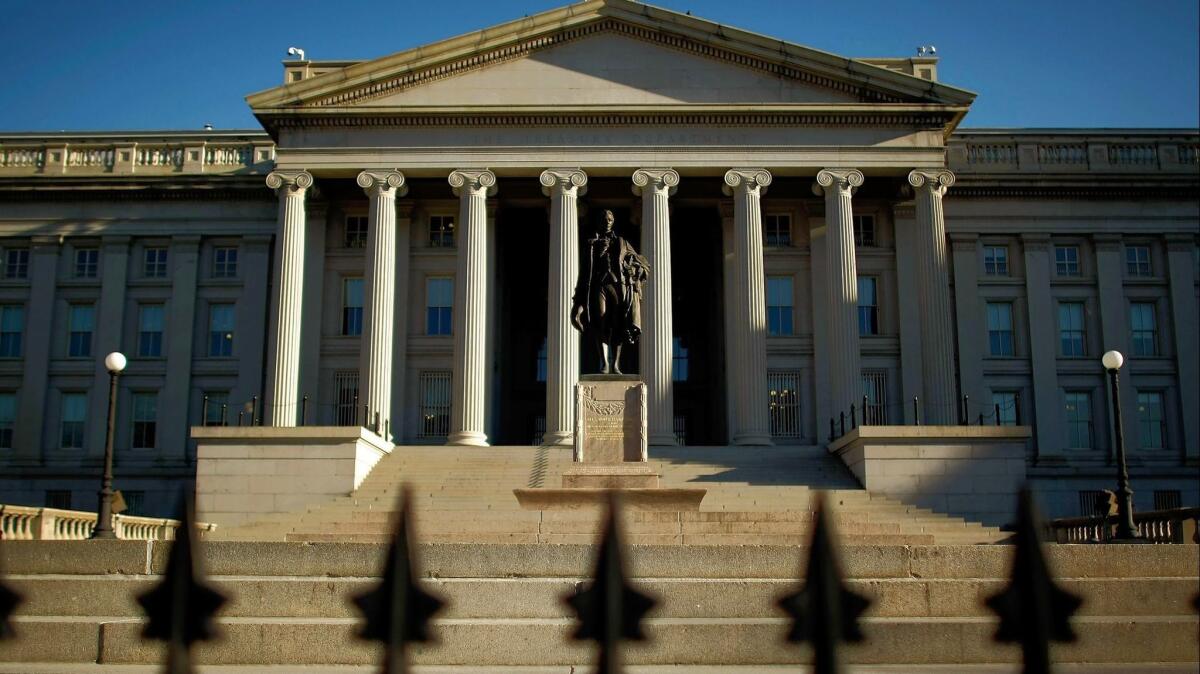As federal deficit approaches $1 trillion, investors are losing their appetite for U.S. debt

- Share via
As the U.S. government kicks off its debt sales this year, here’s one potentially worrisome sign for traders to keep in mind: the steep decline in demand at its bond auctions.
Of the $2.4 trillion of notes and bonds the Treasury Department offered last year, investors submitted bids for just 2.6 times that amount, data compiled by Bloomberg show. That’s less than in any year since 2008 when the financial crisis was in full swing. The bid-to-cover ratio, as it’s known, fell even as benchmark Treasury yields soared to multiyear highs in October, before falling back to their lows last month.
Granted, it’s not as if the U.S. will have trouble borrowing as much as it needs. And there’s little in the data to suggest weak auctions lead to bond losses. Yet the drop-off serves as an early warning that demand for Treasurys may not keep up as the U.S. goes deeper in the red.
Debt supply jumped in 2018 largely because of the Trump administration’s tax cuts. Forecasts show the deficit could soon swell past a trillion dollars and stay that way for years to come.
The weakness “doesn’t matter until it suddenly does,” says Torsten Slok, Deutsche Bank’s chief international economist. “A declining bid-to-cover ratio increases the vulnerability and probability that investors suddenly will begin to think that a falling bid-to-cover ratio is important. Put differently, all fiscal crises begin with a declining bid-to-cover ratio.”
The first note auction of 2019 did little to ease those worries. The Treasury sold $38 billion of three-year notes Tuesday, matching the biggest sale since 2010. The bid-to-cover ratio was the lowest since 2009. It will follow up Wednesday with a $24-billion sale of 10-year notes, which yield 2.73%.
The Treasury has enlarged its auctions for four straight quarters, surpassing levels last seen in 2009. What’s more, the U.S. has grown more reliant on the public to finance its deficit as the Federal Reserve scales back its purchases of Treasurys to shrink its $4 trillion of crisis-era bond holdings.
To some Wall Street observers, the drop in bid-to-cover ratios is merely a mathematical necessity rather than a cause for alarm.
“We’ve seen record high auction sizes, so decade-low bid-to-cover makes sense,” said Ian Lyngen, head of U.S. interest rate strategy at BMO Capital Markets. “I would expect, mechanically, for bid-to-cover ratios to come down, just because there’s not endless, insatiable demand out there for Treasurys.”
Lyngen says he’s on the lookout for so-called tails for signs of stress at auctions. A tail occurs when the auction yield is higher than the prevailing market rate for the securities at the time bids close. And a larger tail indicates that bond investors are demanding a bigger concession for the offering.
Yet there too, some cracks have started to emerge.
The three-year maturity has produced five tails over its last seven auctions, including Tuesday’s, according to Jefferies Financial Group. Auctions have tended to be “sloppier” since the Treasury increased its borrowing in February, said Tom Simons, the firm’s money markets economist. Continued weakness in auction demand could lead to larger tails this year, he said.
“If auction sizes start rising later in the year and inflation picks back up,” he said, “then the second half of the year could get hairy.”
Greifeld writes for Bloomberg.
More to Read
Inside the business of entertainment
The Wide Shot brings you news, analysis and insights on everything from streaming wars to production — and what it all means for the future.
You may occasionally receive promotional content from the Los Angeles Times.










